Types of Non-Verbal Communication in Business Communications
VerifiedAdded on 2022/11/22
|7
|1476
|56
AI Summary
This paper outlines the types of non-verbal communication in business communications, providing examples of each type and explaining their role. It recognizes three types of non-verbal communication and describes the relationships between speaking and listening skills and non-verbal communication.
Contribute Materials
Your contribution can guide someone’s learning journey. Share your
documents today.

1
BUSINESS COMMUNICATIONS
Business Communications
Name of the Student
Name of the University
Author Note
BUSINESS COMMUNICATIONS
Business Communications
Name of the Student
Name of the University
Author Note
Secure Best Marks with AI Grader
Need help grading? Try our AI Grader for instant feedback on your assignments.
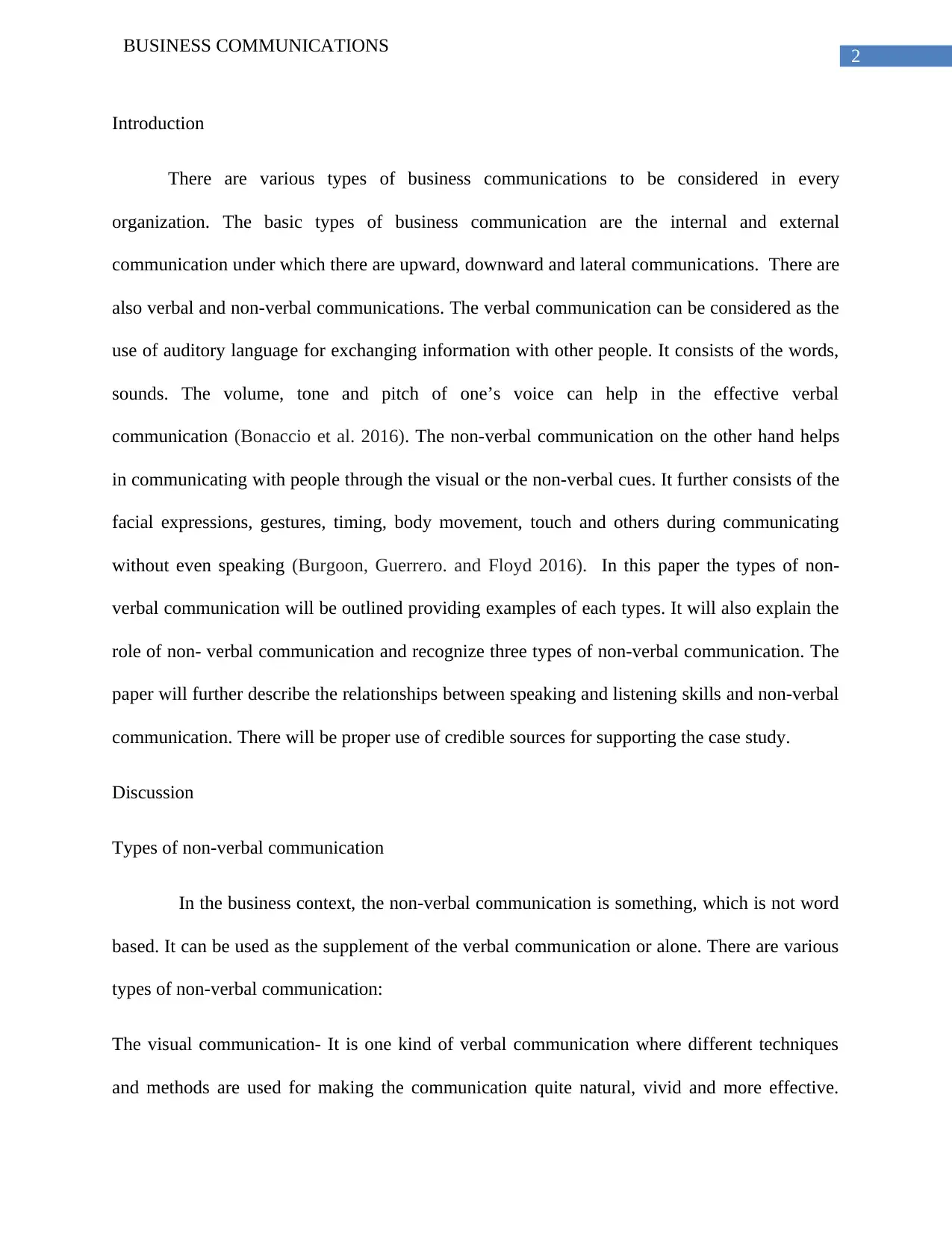
2
BUSINESS COMMUNICATIONS
Introduction
There are various types of business communications to be considered in every
organization. The basic types of business communication are the internal and external
communication under which there are upward, downward and lateral communications. There are
also verbal and non-verbal communications. The verbal communication can be considered as the
use of auditory language for exchanging information with other people. It consists of the words,
sounds. The volume, tone and pitch of one’s voice can help in the effective verbal
communication (Bonaccio et al. 2016). The non-verbal communication on the other hand helps
in communicating with people through the visual or the non-verbal cues. It further consists of the
facial expressions, gestures, timing, body movement, touch and others during communicating
without even speaking (Burgoon, Guerrero. and Floyd 2016). In this paper the types of non-
verbal communication will be outlined providing examples of each types. It will also explain the
role of non- verbal communication and recognize three types of non-verbal communication. The
paper will further describe the relationships between speaking and listening skills and non-verbal
communication. There will be proper use of credible sources for supporting the case study.
Discussion
Types of non-verbal communication
In the business context, the non-verbal communication is something, which is not word
based. It can be used as the supplement of the verbal communication or alone. There are various
types of non-verbal communication:
The visual communication- It is one kind of verbal communication where different techniques
and methods are used for making the communication quite natural, vivid and more effective.
BUSINESS COMMUNICATIONS
Introduction
There are various types of business communications to be considered in every
organization. The basic types of business communication are the internal and external
communication under which there are upward, downward and lateral communications. There are
also verbal and non-verbal communications. The verbal communication can be considered as the
use of auditory language for exchanging information with other people. It consists of the words,
sounds. The volume, tone and pitch of one’s voice can help in the effective verbal
communication (Bonaccio et al. 2016). The non-verbal communication on the other hand helps
in communicating with people through the visual or the non-verbal cues. It further consists of the
facial expressions, gestures, timing, body movement, touch and others during communicating
without even speaking (Burgoon, Guerrero. and Floyd 2016). In this paper the types of non-
verbal communication will be outlined providing examples of each types. It will also explain the
role of non- verbal communication and recognize three types of non-verbal communication. The
paper will further describe the relationships between speaking and listening skills and non-verbal
communication. There will be proper use of credible sources for supporting the case study.
Discussion
Types of non-verbal communication
In the business context, the non-verbal communication is something, which is not word
based. It can be used as the supplement of the verbal communication or alone. There are various
types of non-verbal communication:
The visual communication- It is one kind of verbal communication where different techniques
and methods are used for making the communication quite natural, vivid and more effective.
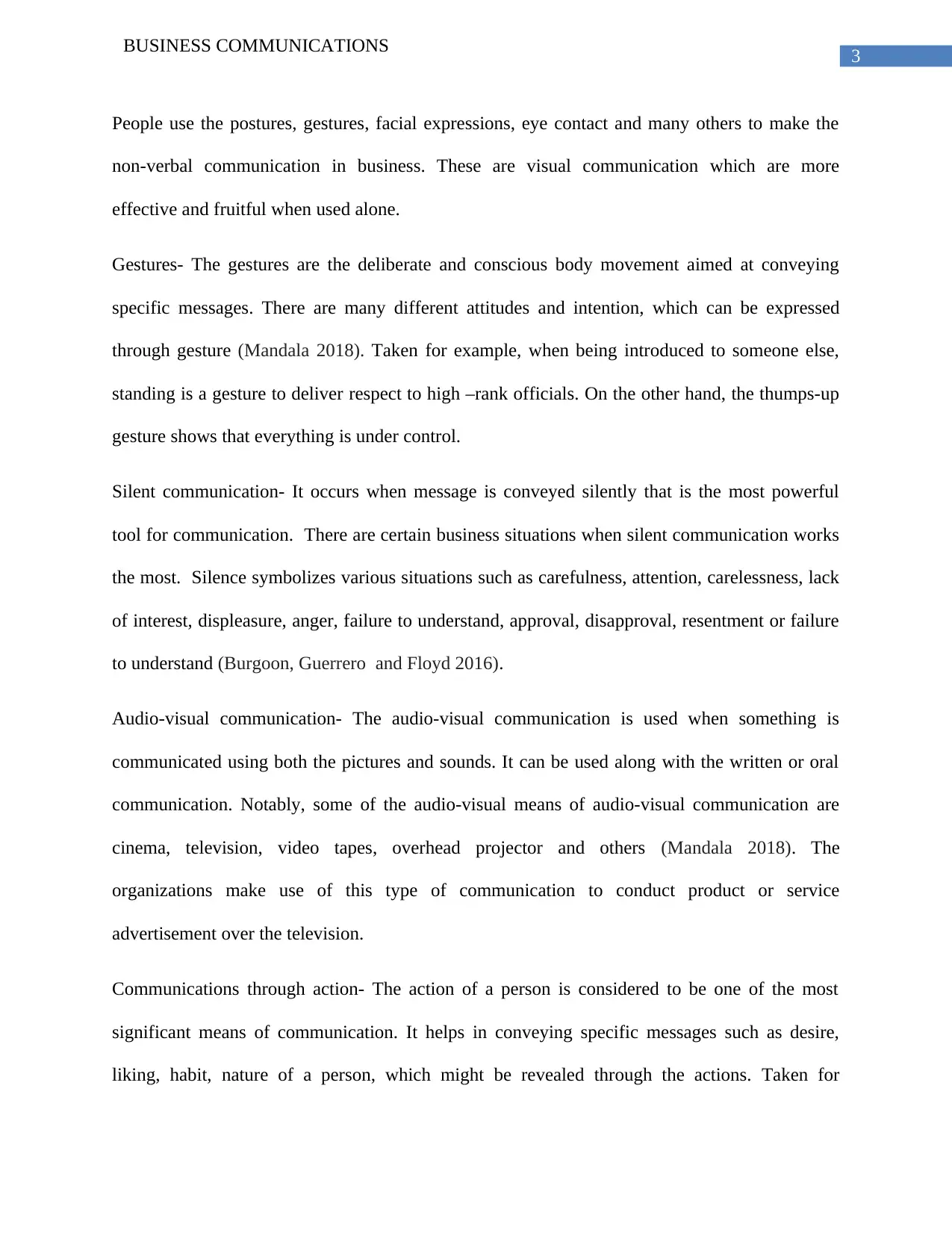
3
BUSINESS COMMUNICATIONS
People use the postures, gestures, facial expressions, eye contact and many others to make the
non-verbal communication in business. These are visual communication which are more
effective and fruitful when used alone.
Gestures- The gestures are the deliberate and conscious body movement aimed at conveying
specific messages. There are many different attitudes and intention, which can be expressed
through gesture (Mandala 2018). Taken for example, when being introduced to someone else,
standing is a gesture to deliver respect to high –rank officials. On the other hand, the thumps-up
gesture shows that everything is under control.
Silent communication- It occurs when message is conveyed silently that is the most powerful
tool for communication. There are certain business situations when silent communication works
the most. Silence symbolizes various situations such as carefulness, attention, carelessness, lack
of interest, displeasure, anger, failure to understand, approval, disapproval, resentment or failure
to understand (Burgoon, Guerrero and Floyd 2016).
Audio-visual communication- The audio-visual communication is used when something is
communicated using both the pictures and sounds. It can be used along with the written or oral
communication. Notably, some of the audio-visual means of audio-visual communication are
cinema, television, video tapes, overhead projector and others (Mandala 2018). The
organizations make use of this type of communication to conduct product or service
advertisement over the television.
Communications through action- The action of a person is considered to be one of the most
significant means of communication. It helps in conveying specific messages such as desire,
liking, habit, nature of a person, which might be revealed through the actions. Taken for
BUSINESS COMMUNICATIONS
People use the postures, gestures, facial expressions, eye contact and many others to make the
non-verbal communication in business. These are visual communication which are more
effective and fruitful when used alone.
Gestures- The gestures are the deliberate and conscious body movement aimed at conveying
specific messages. There are many different attitudes and intention, which can be expressed
through gesture (Mandala 2018). Taken for example, when being introduced to someone else,
standing is a gesture to deliver respect to high –rank officials. On the other hand, the thumps-up
gesture shows that everything is under control.
Silent communication- It occurs when message is conveyed silently that is the most powerful
tool for communication. There are certain business situations when silent communication works
the most. Silence symbolizes various situations such as carefulness, attention, carelessness, lack
of interest, displeasure, anger, failure to understand, approval, disapproval, resentment or failure
to understand (Burgoon, Guerrero and Floyd 2016).
Audio-visual communication- The audio-visual communication is used when something is
communicated using both the pictures and sounds. It can be used along with the written or oral
communication. Notably, some of the audio-visual means of audio-visual communication are
cinema, television, video tapes, overhead projector and others (Mandala 2018). The
organizations make use of this type of communication to conduct product or service
advertisement over the television.
Communications through action- The action of a person is considered to be one of the most
significant means of communication. It helps in conveying specific messages such as desire,
liking, habit, nature of a person, which might be revealed through the actions. Taken for
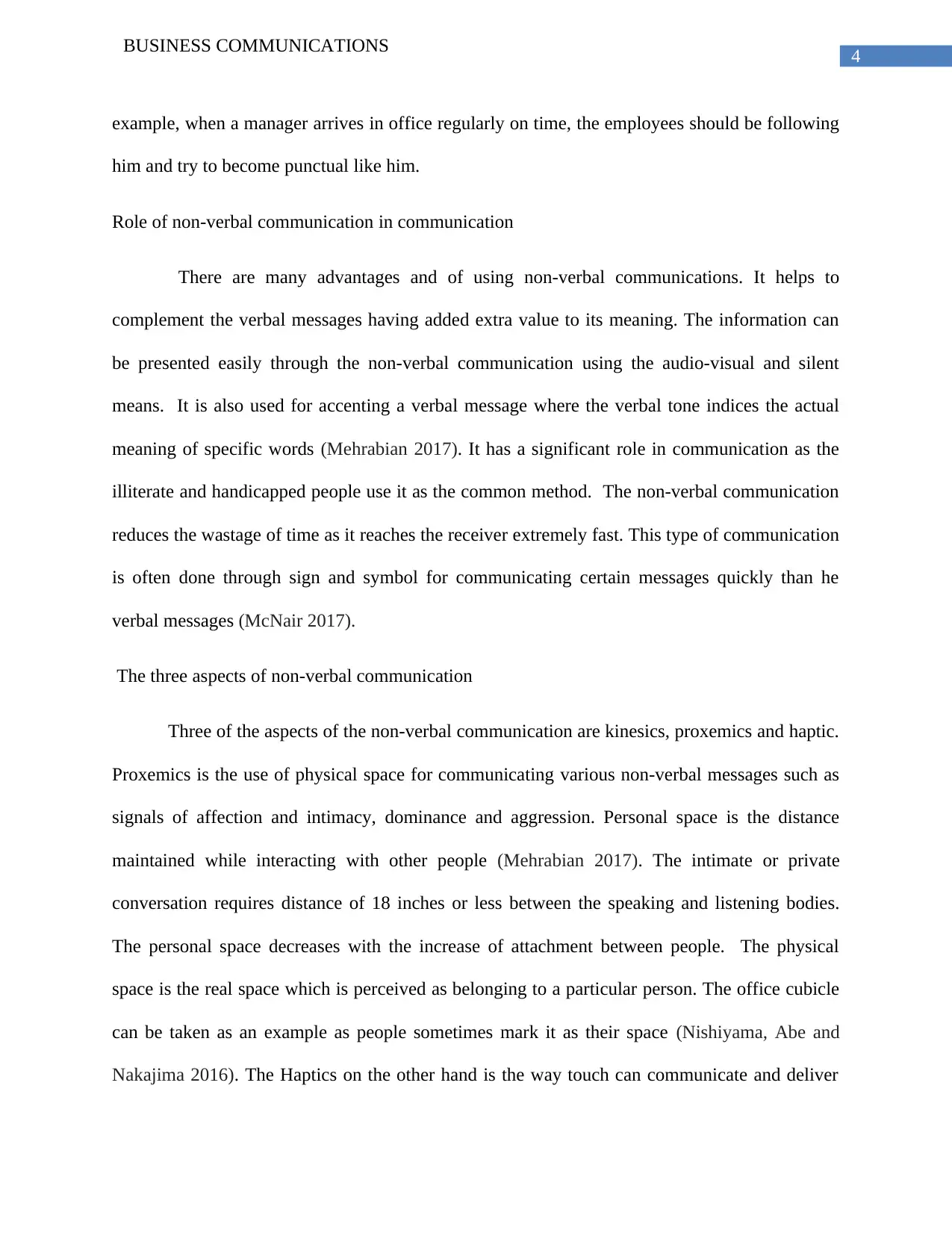
4
BUSINESS COMMUNICATIONS
example, when a manager arrives in office regularly on time, the employees should be following
him and try to become punctual like him.
Role of non-verbal communication in communication
There are many advantages and of using non-verbal communications. It helps to
complement the verbal messages having added extra value to its meaning. The information can
be presented easily through the non-verbal communication using the audio-visual and silent
means. It is also used for accenting a verbal message where the verbal tone indices the actual
meaning of specific words (Mehrabian 2017). It has a significant role in communication as the
illiterate and handicapped people use it as the common method. The non-verbal communication
reduces the wastage of time as it reaches the receiver extremely fast. This type of communication
is often done through sign and symbol for communicating certain messages quickly than he
verbal messages (McNair 2017).
The three aspects of non-verbal communication
Three of the aspects of the non-verbal communication are kinesics, proxemics and haptic.
Proxemics is the use of physical space for communicating various non-verbal messages such as
signals of affection and intimacy, dominance and aggression. Personal space is the distance
maintained while interacting with other people (Mehrabian 2017). The intimate or private
conversation requires distance of 18 inches or less between the speaking and listening bodies.
The personal space decreases with the increase of attachment between people. The physical
space is the real space which is perceived as belonging to a particular person. The office cubicle
can be taken as an example as people sometimes mark it as their space (Nishiyama, Abe and
Nakajima 2016). The Haptics on the other hand is the way touch can communicate and deliver
BUSINESS COMMUNICATIONS
example, when a manager arrives in office regularly on time, the employees should be following
him and try to become punctual like him.
Role of non-verbal communication in communication
There are many advantages and of using non-verbal communications. It helps to
complement the verbal messages having added extra value to its meaning. The information can
be presented easily through the non-verbal communication using the audio-visual and silent
means. It is also used for accenting a verbal message where the verbal tone indices the actual
meaning of specific words (Mehrabian 2017). It has a significant role in communication as the
illiterate and handicapped people use it as the common method. The non-verbal communication
reduces the wastage of time as it reaches the receiver extremely fast. This type of communication
is often done through sign and symbol for communicating certain messages quickly than he
verbal messages (McNair 2017).
The three aspects of non-verbal communication
Three of the aspects of the non-verbal communication are kinesics, proxemics and haptic.
Proxemics is the use of physical space for communicating various non-verbal messages such as
signals of affection and intimacy, dominance and aggression. Personal space is the distance
maintained while interacting with other people (Mehrabian 2017). The intimate or private
conversation requires distance of 18 inches or less between the speaking and listening bodies.
The personal space decreases with the increase of attachment between people. The physical
space is the real space which is perceived as belonging to a particular person. The office cubicle
can be taken as an example as people sometimes mark it as their space (Nishiyama, Abe and
Nakajima 2016). The Haptics on the other hand is the way touch can communicate and deliver
Secure Best Marks with AI Grader
Need help grading? Try our AI Grader for instant feedback on your assignments.
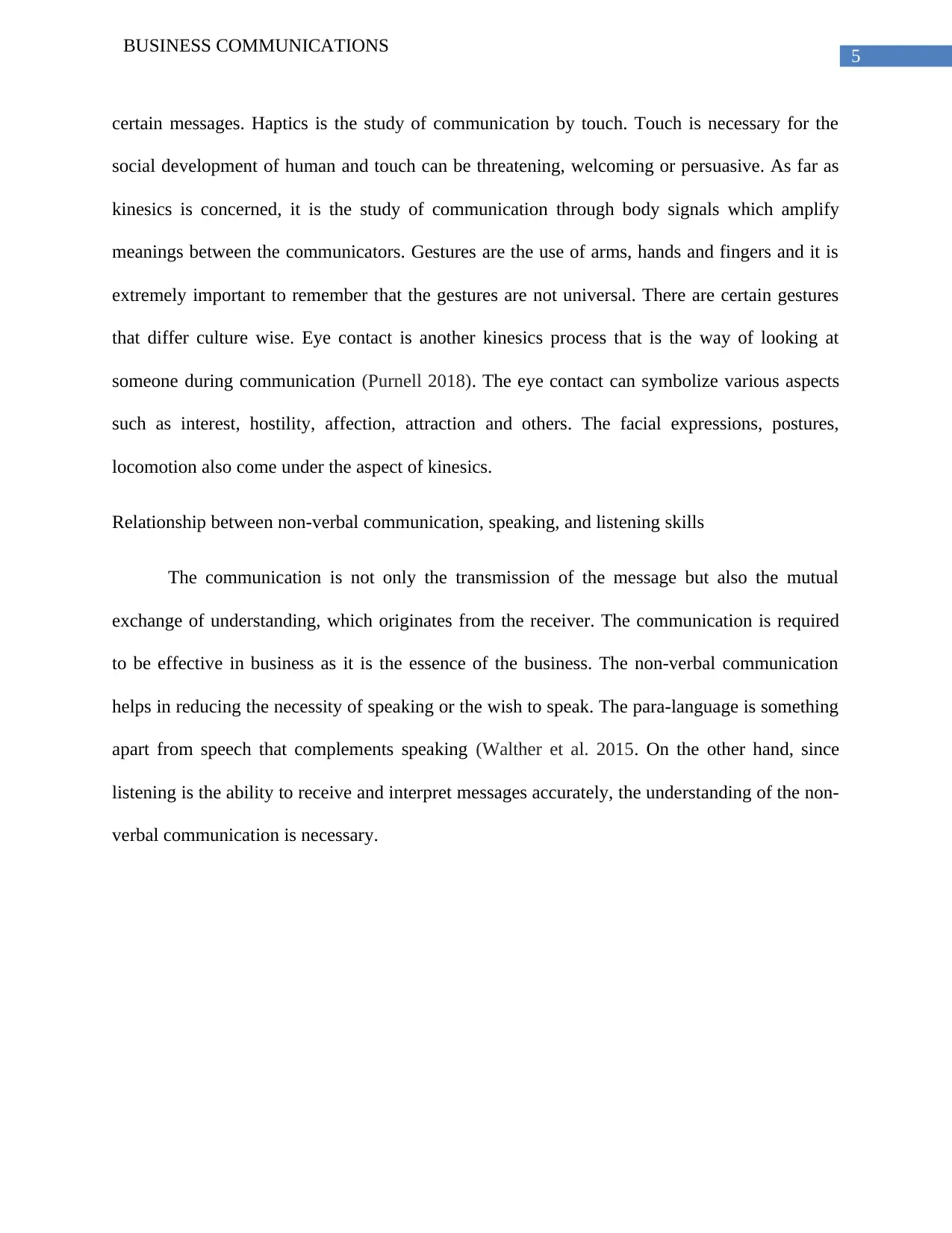
5
BUSINESS COMMUNICATIONS
certain messages. Haptics is the study of communication by touch. Touch is necessary for the
social development of human and touch can be threatening, welcoming or persuasive. As far as
kinesics is concerned, it is the study of communication through body signals which amplify
meanings between the communicators. Gestures are the use of arms, hands and fingers and it is
extremely important to remember that the gestures are not universal. There are certain gestures
that differ culture wise. Eye contact is another kinesics process that is the way of looking at
someone during communication (Purnell 2018). The eye contact can symbolize various aspects
such as interest, hostility, affection, attraction and others. The facial expressions, postures,
locomotion also come under the aspect of kinesics.
Relationship between non-verbal communication, speaking, and listening skills
The communication is not only the transmission of the message but also the mutual
exchange of understanding, which originates from the receiver. The communication is required
to be effective in business as it is the essence of the business. The non-verbal communication
helps in reducing the necessity of speaking or the wish to speak. The para-language is something
apart from speech that complements speaking (Walther et al. 2015. On the other hand, since
listening is the ability to receive and interpret messages accurately, the understanding of the non-
verbal communication is necessary.
BUSINESS COMMUNICATIONS
certain messages. Haptics is the study of communication by touch. Touch is necessary for the
social development of human and touch can be threatening, welcoming or persuasive. As far as
kinesics is concerned, it is the study of communication through body signals which amplify
meanings between the communicators. Gestures are the use of arms, hands and fingers and it is
extremely important to remember that the gestures are not universal. There are certain gestures
that differ culture wise. Eye contact is another kinesics process that is the way of looking at
someone during communication (Purnell 2018). The eye contact can symbolize various aspects
such as interest, hostility, affection, attraction and others. The facial expressions, postures,
locomotion also come under the aspect of kinesics.
Relationship between non-verbal communication, speaking, and listening skills
The communication is not only the transmission of the message but also the mutual
exchange of understanding, which originates from the receiver. The communication is required
to be effective in business as it is the essence of the business. The non-verbal communication
helps in reducing the necessity of speaking or the wish to speak. The para-language is something
apart from speech that complements speaking (Walther et al. 2015. On the other hand, since
listening is the ability to receive and interpret messages accurately, the understanding of the non-
verbal communication is necessary.
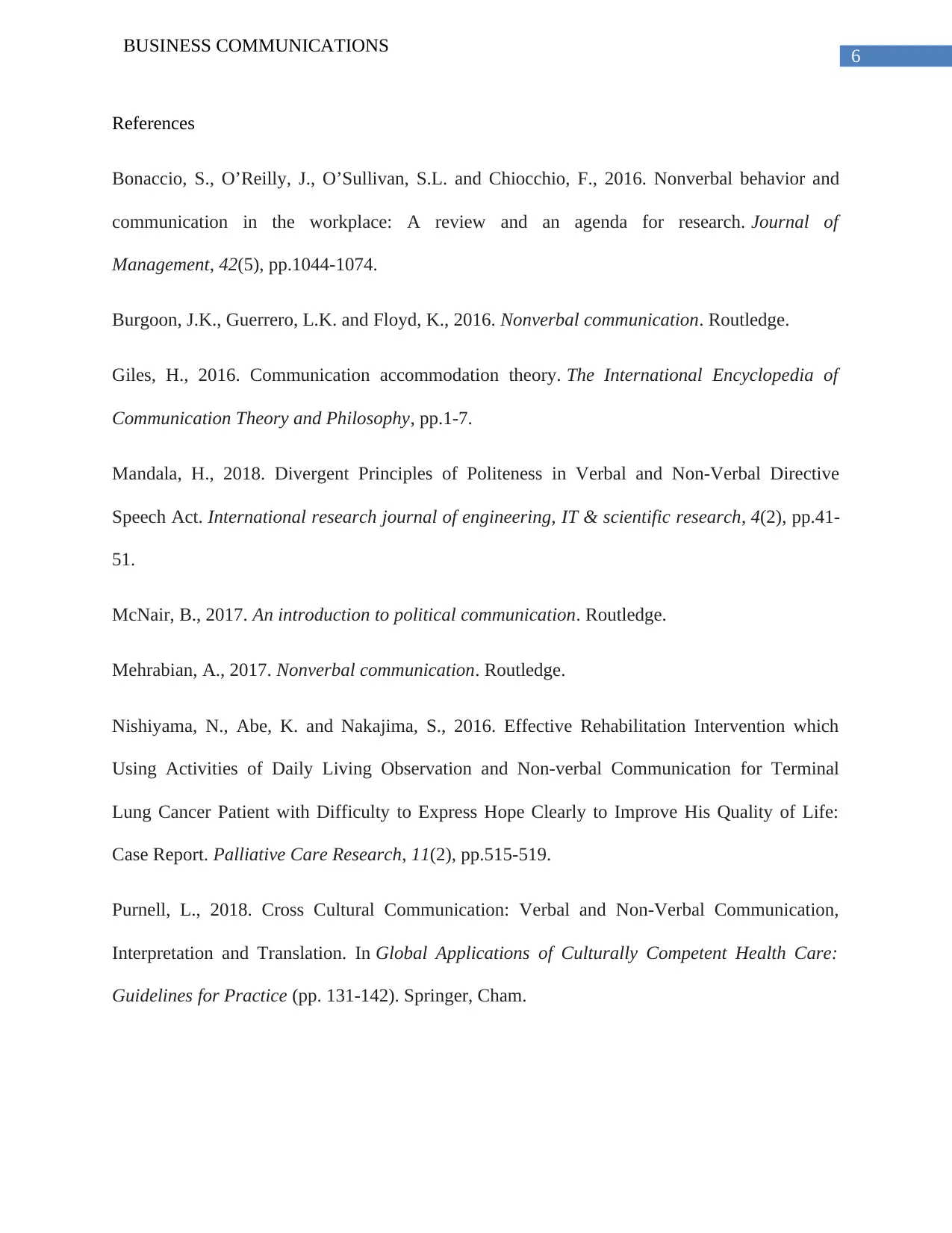
6
BUSINESS COMMUNICATIONS
References
Bonaccio, S., O’Reilly, J., O’Sullivan, S.L. and Chiocchio, F., 2016. Nonverbal behavior and
communication in the workplace: A review and an agenda for research. Journal of
Management, 42(5), pp.1044-1074.
Burgoon, J.K., Guerrero, L.K. and Floyd, K., 2016. Nonverbal communication. Routledge.
Giles, H., 2016. Communication accommodation theory. The International Encyclopedia of
Communication Theory and Philosophy, pp.1-7.
Mandala, H., 2018. Divergent Principles of Politeness in Verbal and Non-Verbal Directive
Speech Act. International research journal of engineering, IT & scientific research, 4(2), pp.41-
51.
McNair, B., 2017. An introduction to political communication. Routledge.
Mehrabian, A., 2017. Nonverbal communication. Routledge.
Nishiyama, N., Abe, K. and Nakajima, S., 2016. Effective Rehabilitation Intervention which
Using Activities of Daily Living Observation and Non-verbal Communication for Terminal
Lung Cancer Patient with Difficulty to Express Hope Clearly to Improve His Quality of Life:
Case Report. Palliative Care Research, 11(2), pp.515-519.
Purnell, L., 2018. Cross Cultural Communication: Verbal and Non-Verbal Communication,
Interpretation and Translation. In Global Applications of Culturally Competent Health Care:
Guidelines for Practice (pp. 131-142). Springer, Cham.
BUSINESS COMMUNICATIONS
References
Bonaccio, S., O’Reilly, J., O’Sullivan, S.L. and Chiocchio, F., 2016. Nonverbal behavior and
communication in the workplace: A review and an agenda for research. Journal of
Management, 42(5), pp.1044-1074.
Burgoon, J.K., Guerrero, L.K. and Floyd, K., 2016. Nonverbal communication. Routledge.
Giles, H., 2016. Communication accommodation theory. The International Encyclopedia of
Communication Theory and Philosophy, pp.1-7.
Mandala, H., 2018. Divergent Principles of Politeness in Verbal and Non-Verbal Directive
Speech Act. International research journal of engineering, IT & scientific research, 4(2), pp.41-
51.
McNair, B., 2017. An introduction to political communication. Routledge.
Mehrabian, A., 2017. Nonverbal communication. Routledge.
Nishiyama, N., Abe, K. and Nakajima, S., 2016. Effective Rehabilitation Intervention which
Using Activities of Daily Living Observation and Non-verbal Communication for Terminal
Lung Cancer Patient with Difficulty to Express Hope Clearly to Improve His Quality of Life:
Case Report. Palliative Care Research, 11(2), pp.515-519.
Purnell, L., 2018. Cross Cultural Communication: Verbal and Non-Verbal Communication,
Interpretation and Translation. In Global Applications of Culturally Competent Health Care:
Guidelines for Practice (pp. 131-142). Springer, Cham.

7
BUSINESS COMMUNICATIONS
Walther, J.B., Van Der Heide, B., Ramirez, A., Burgoon, J.K. and Peña, J., 2015. Interpersonal
and hyperpersonal dimensions of computer-mediated communication. The handbook of the
psychology of communication technology, 1, p.22.
BUSINESS COMMUNICATIONS
Walther, J.B., Van Der Heide, B., Ramirez, A., Burgoon, J.K. and Peña, J., 2015. Interpersonal
and hyperpersonal dimensions of computer-mediated communication. The handbook of the
psychology of communication technology, 1, p.22.
1 out of 7
Your All-in-One AI-Powered Toolkit for Academic Success.
+13062052269
info@desklib.com
Available 24*7 on WhatsApp / Email
![[object Object]](/_next/static/media/star-bottom.7253800d.svg)
Unlock your academic potential
© 2024 | Zucol Services PVT LTD | All rights reserved.





